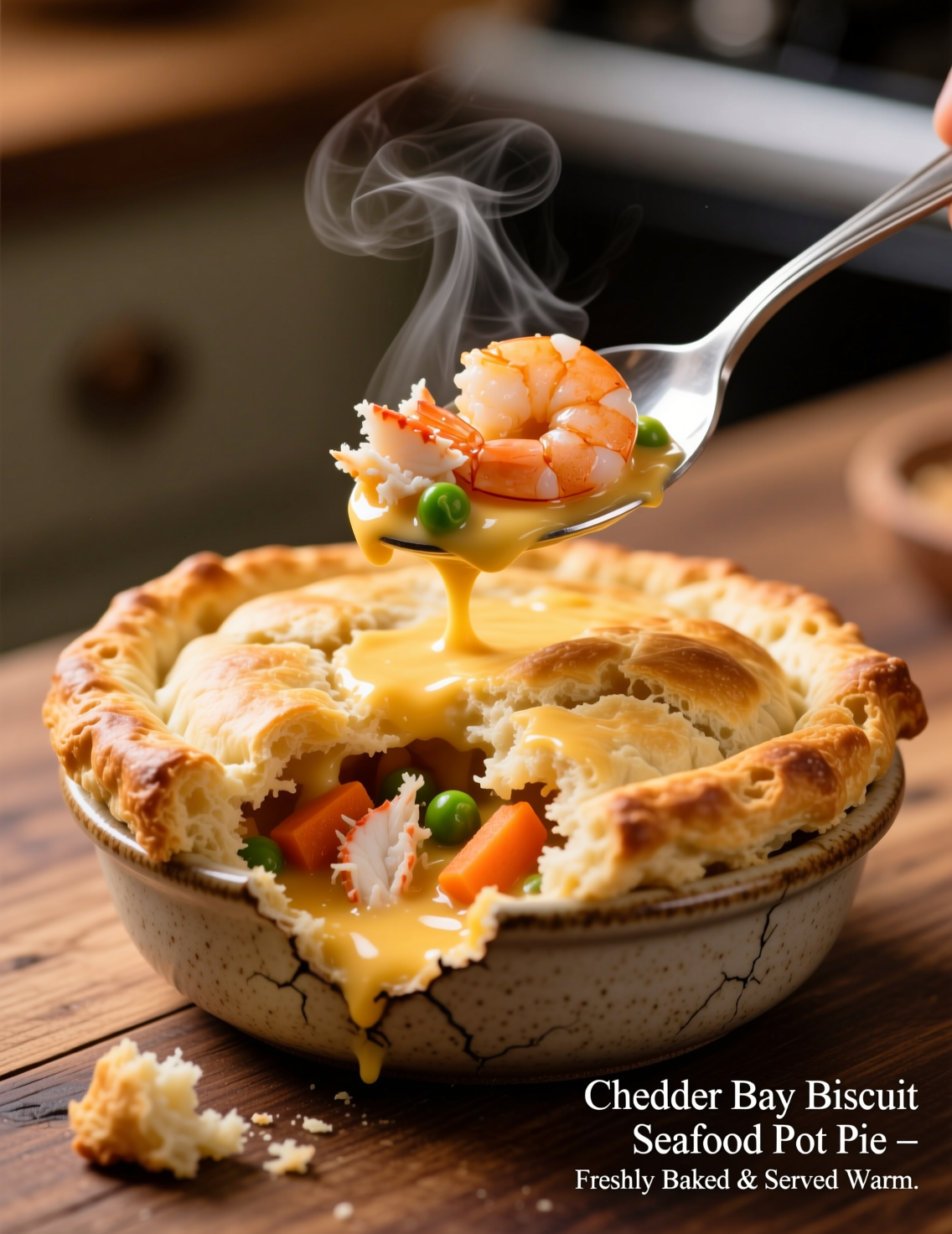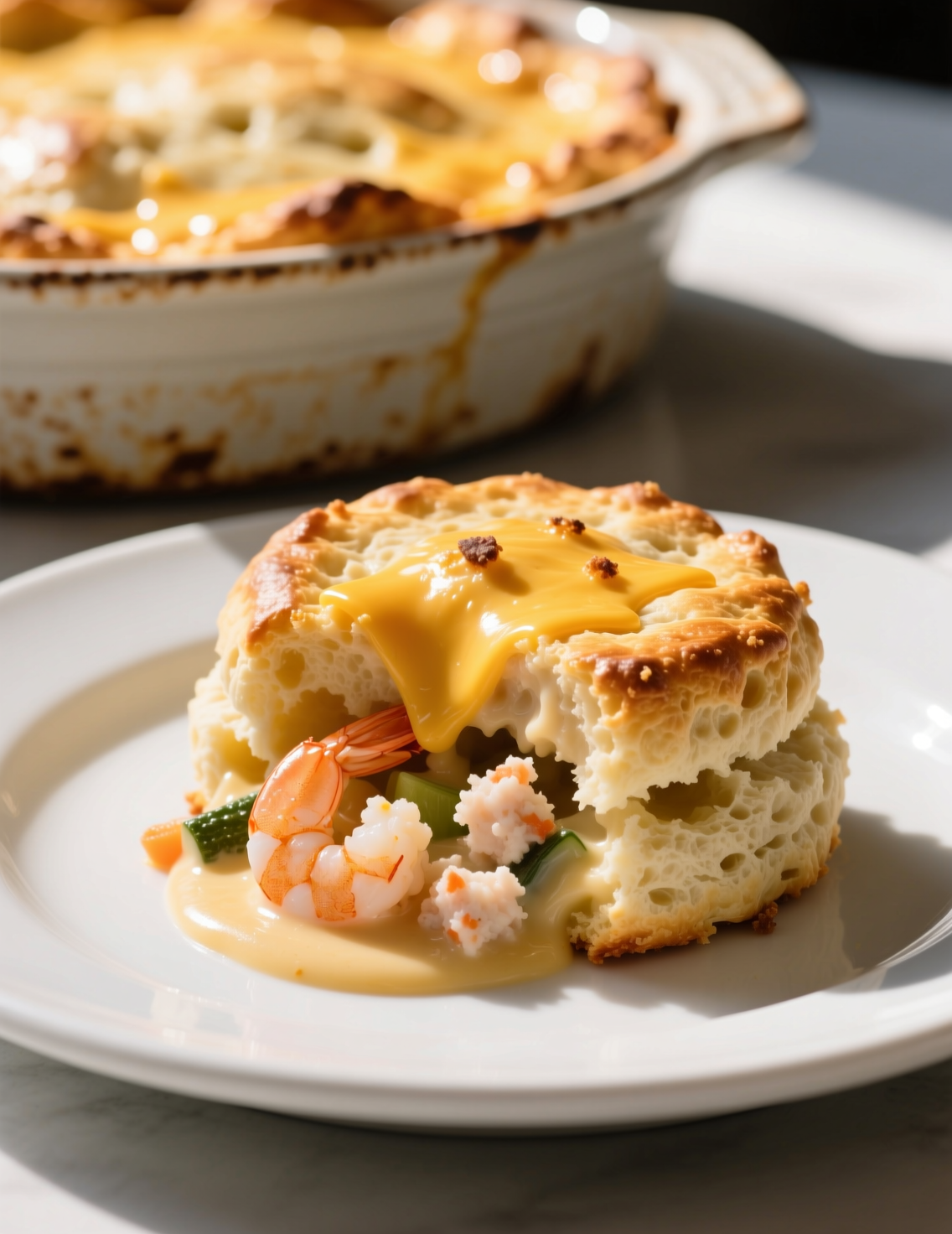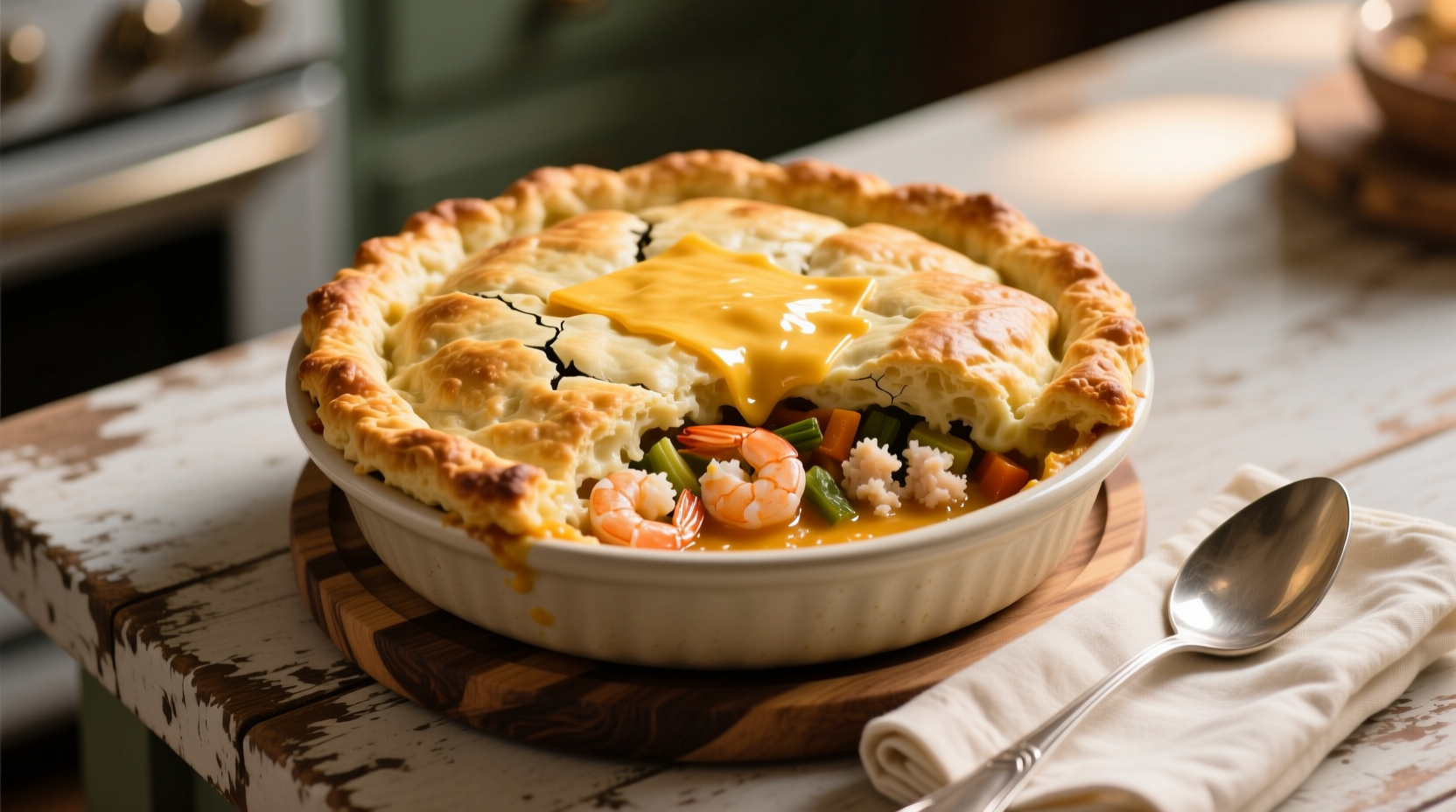There are dishes that whisper comfort, and there are dishes that shout it out loud from the kitchen doorway. Cheddar Bay Biscuit Seafood Pot Pie falls into the latter. This isn’t just some creamy stew hidden under a lid of dough—it’s a layered symphony of buttery biscuits, velvety seafood sauce, and flavors that hit the tongue like memory. If you’re reading this, you probably already know that seafood pot pie is not new. But combining it with cheddar bay biscuits? That’s a culinary twist that professional chefs should not dismiss as mere restaurant gimmick.
Why This Dish Stands Out
Seafood pot pie by itself already demands technical finesse. Balancing cream, stock, and delicate proteins is not the same game as tossing chicken into gravy. Overcook scallops and they turn rubbery. Let shrimp sit too long in the sauce and suddenly you’ve wasted money and flavor. Now imagine doing all that while calculating the hydration ratio for drop biscuits that need to rise properly on top of the filling. This isn’t “comfort food lite.” It’s precision cooking dressed up in cozy clothes.
A 2022 report by the National Fisheries Institute noted seafood consumption in the U.S. rose by 6% from the previous year, with shrimp and salmon leading the charge. Recipes like this one ride that trend because diners crave luxury that still feels familiar. In professional kitchens, this dish also lets chefs highlight regional seafood—lobster in Maine, crawfish in Louisiana, rockfish on the West Coast—while keeping a structure that customers recognize.
Ingredients: Balancing Familiar with Elevated
For six servings, you’ll want to think in terms of both weight and function. The filling is not a dumping ground for whatever seafood you have lying around. It’s a canvas that should be thought through.
Seafood filling
- 1 lb shrimp, peeled and deveined
- 1/2 lb scallops (bay scallops preferred for size consistency)
- 1/2 lb lump crab meat (jumbo if budget allows)
- 1 cup diced carrots
- 1 cup celery, diced small
- 1 medium onion, finely chopped
- 2 cloves garlic, minced
- 4 tbsp unsalted butter
- 1/3 cup all-purpose flour
- 2 cups seafood stock (homemade stock from shrimp shells is ideal)
- 1 cup heavy cream
- 1/2 cup dry white wine (Sauvignon Blanc or Pinot Grigio works)
- 1 tsp Old Bay seasoning
- 1/2 tsp smoked paprika
- Fresh thyme sprigs, 2 or 3
- Salt and cracked pepper, to taste
Cheddar Bay Biscuits (topping)
- 2 cups all-purpose flour
- 1 tbsp baking powder
- 1 tsp garlic powder
- 1 tsp sugar
- 1/2 tsp salt
- 1/2 cup unsalted butter, very cold and cubed
- 1 cup sharp cheddar cheese, shredded
- 3/4 cup whole milk (plus 1 tbsp for brushing tops)
- 2 tbsp chopped parsley
Chefs who want more depth can fold in a teaspoon of fish sauce or miso paste into the filling base. Sounds strange, but umami turns the volume knob up without guests knowing exactly why.

Technique: The Critical Steps
Building the Base
Sweating vegetables is not glamorous but it sets the pace. Carrots and celery should be cut small enough to soften quickly without vanishing into mush. Butter should foam, not brown—unless you want nutty undertones in your sauce, which can sometimes fight the seafood. Garlic should kiss the pan for no more than 30 seconds; let it go longer and you’re making bitterness soup.
When adding flour, think of it as armor. It coats each vegetable piece and suspends them so the roux doesn’t clump. Stir for a full two minutes. Any less, you’ll taste raw flour; any more, you’ll darken the base, shifting the flavor profile away from the creamy, bright seafood notes.
Liquid Precision
Adding seafood stock and cream in sequence matters. Stock first, whisking continuously to smooth. Cream after, lowering the heat, because cream on high heat is a temperamental diva—it splits and ruins your sauce if you look away too long. Wine slides in between these steps, reduced by half to burn away alcohol.
Old Bay, thyme, and paprika layer in warmth. Don’t dump them in together. Add thyme earlier with the stock to infuse. Seasoning powders after cream to bloom in fat. Little tricks like that make kitchens run smarter.
Cooking the Seafood
Drop shrimp, scallops, and crab into the sauce only after it’s off the direct flame. Residual heat cooks them gently. Think carryover cooking but inside the sauce. Scallops, especially, need no more than 3 minutes. Chefs who throw everything in at once, then bake, often end up with seafood that tastes like the texture of pencil erasers.
Biscuit Science
Cheddar Bay biscuits are essentially drop biscuits with garlic powder, cheddar, and parsley. The key is cold fat. The colder the butter, the more distinct steam pockets form during baking, and the more flakey-craggy texture develops. Professionals sometimes grate frozen butter into the flour mix—it distributes fat evenly without overworking the dough.
Stir just until the dough holds together. Overmixing builds gluten, which turns biscuits into dense hockey pucks. Drop spoonfuls onto the pot pie filling, leaving gaps for steam release. Gaps are not mistakes; they’re vents. Without them, the biscuits steam and turn gummy on their undersides.
Assembly and Baking
A 9×13-inch baking dish works well for six servings, though individual ramekins deliver more controlled presentation. Spoon filling into the vessel, making sure seafood distributes evenly. Drop biscuit dough on top, 6–8 mounds. Brush with milk.
Bake at 400°F for 25–30 minutes. The filling should bubble at the edges, biscuits should brown deeply on top. If the biscuits color too fast, tent with foil.
Professional Notes on Pairings
Chefs who serve this in restaurants often underestimate beverage pairing. Heavy Chardonnay with oaky notes will fight the cream. Instead, a crisp Sauvignon Blanc or unoaked Chardonnay cuts the richness. For beer, a pilsner or Kölsch supports seafood without overshadowing it. If you’re going non-alcoholic, a spritz of lemon soda water mirrors acidity without sweetness overload.
Sides should be lean. A shaved fennel salad or lightly dressed arugula keeps the diner refreshed. Anything starchy (mashed potatoes, rice pilaf) is redundant—the biscuits already cover that ground.
Nutritional and Cost Considerations
This dish is not budget-friendly if you insist on premium crab and scallops. On average, depending on region, ingredients for six can hit $45–$60. That puts it at about $7–$10 per serving in food cost, before markup. In restaurants, it works best as a seasonal feature or a weekend special rather than a daily menu item.
Nutrition-wise, one serving can easily cross 500–600 calories, with high protein and calcium from seafood and dairy. Sodium levels creep up due to cheese and Old Bay, so balance with unsalted stock if health-conscious diners are in play.

Common Mistakes Professionals Still Make
- Overloading seafood: Too many varieties confuse the palate. Stick to three max.
- Mishandling biscuits: Warm butter, overmixed dough, or covering the entire surface kills texture.
- Ignoring carryover cooking: Seafood keeps cooking inside hot sauce even after leaving the oven. Pulling early is safer.
- Wrong bakeware: Thin pans scorch filling edges. Ceramic or enameled cast iron distributes heat more evenly.
Emerging Trends Around Pot Pies
According to Datassential’s 2024 food trends report, globalized comfort food is climbing menus. Pot pies with curry bases, miso broth, or Cajun roux are appearing across the U.S. The cheddar bay biscuit topping is itself an evolution of a brand-driven flavor (Red Lobster made it famous), now retooled by chefs to elevate a rustic dish. Don’t be surprised if you see lobster tikka masala pot pies or gochujang seafood pot pies popping up on fusion menus.
Final Thoughts
Cheddar Bay Biscuit Seafood Pot Pie isn’t just hearty—it’s layered culinary logic disguised as comfort. Every element, from how long garlic sits in butter to how cold the butter is in biscuits, determines whether it’s merely edible or unforgettable. Professional kitchens that nail this dish gain more than a plate of food; they gain a memory served hot.
For chefs, the actionable takeaway is simple: respect your seafood, respect your biscuits, and treat the junction of the two like sacred ground. And for home cooks leveling up, don’t fear mistakes. Even a slightly overcooked scallop buried under a golden biscuit crust still beats another night of delivery pizza.
FAQs
What seafood works best in Cheddar Bay Biscuit Seafood Pot Pie?
Shrimp, scallops, and crab are ideal since they balance flavor, texture, and cook evenly.
Can I make this dish ahead of time?
Yes, prepare the filling in advance, refrigerate, and bake with biscuits fresh before serving.
How do I stop seafood from turning rubbery?
Add it off the heat and let gentle residual cooking finish the proteins.
Can I swap the cream for something lighter?
Half-and-half or evaporated milk works, though the sauce won’t be as rich.
Do I have to use seafood stock?
Seafood stock is best, but chicken stock with a splash of fish sauce can substitute.
Why must the butter in biscuits stay cold?
Cold butter creates steam pockets that make the biscuits flakey and tender.
How long does it take to bake?
About 25–30 minutes at 400°F until biscuits are golden and filling is bubbling.
Can I make it in individual portions?
Yes, ramekins make for elegant single-serve presentations with the same method.
What sides pair well with this dish?
Light salads like fennel or arugula keep the meal balanced and refreshing.
Is this recipe expensive to make?
It can be, especially with premium crab or scallops, averaging $7–$10 per serving.

Mariana is a passionate home cook who creates delicious, easy-to-follow recipes for busy people. From energizing breakfasts to satisfying dinners and indulgent desserts, her dishes are designed to fuel both your body and hustle.
When she’s not in the kitchen, she’s exploring new flavors and dreaming up her next recipe to share with the Foodie Hustle community.

